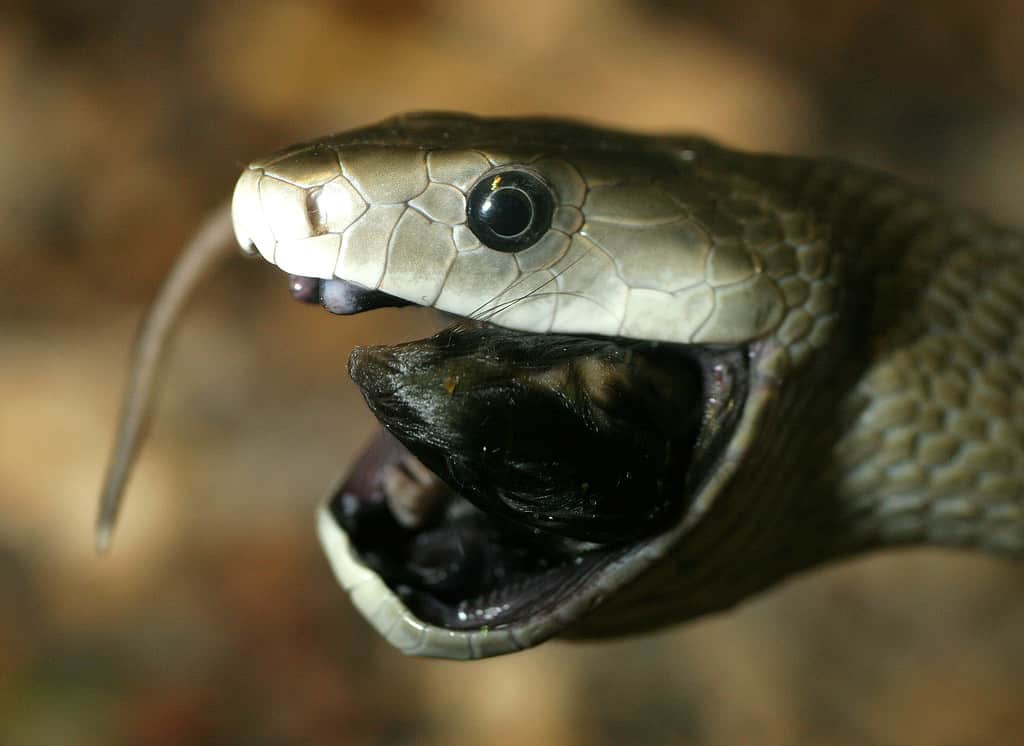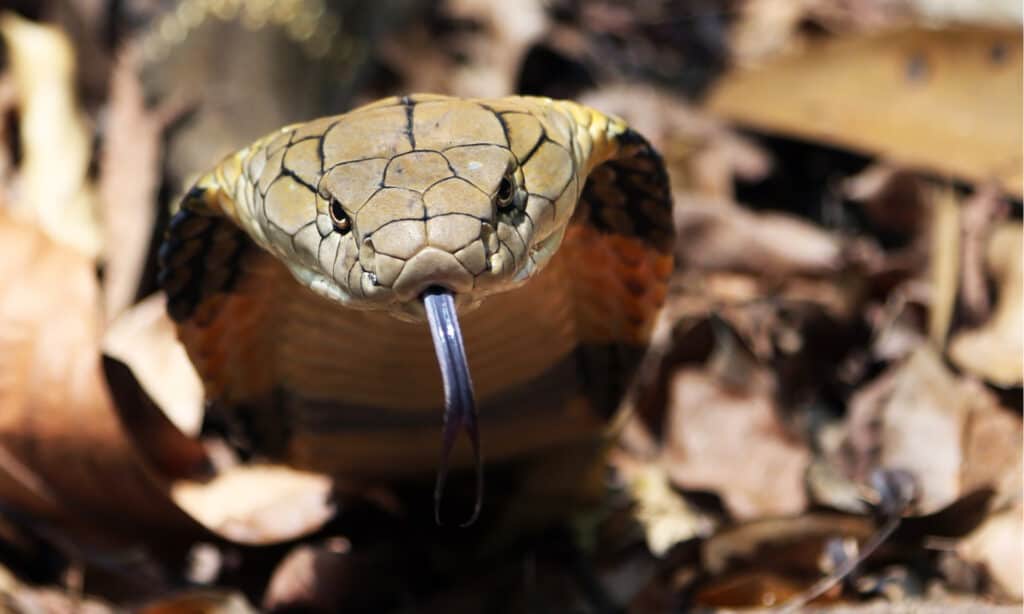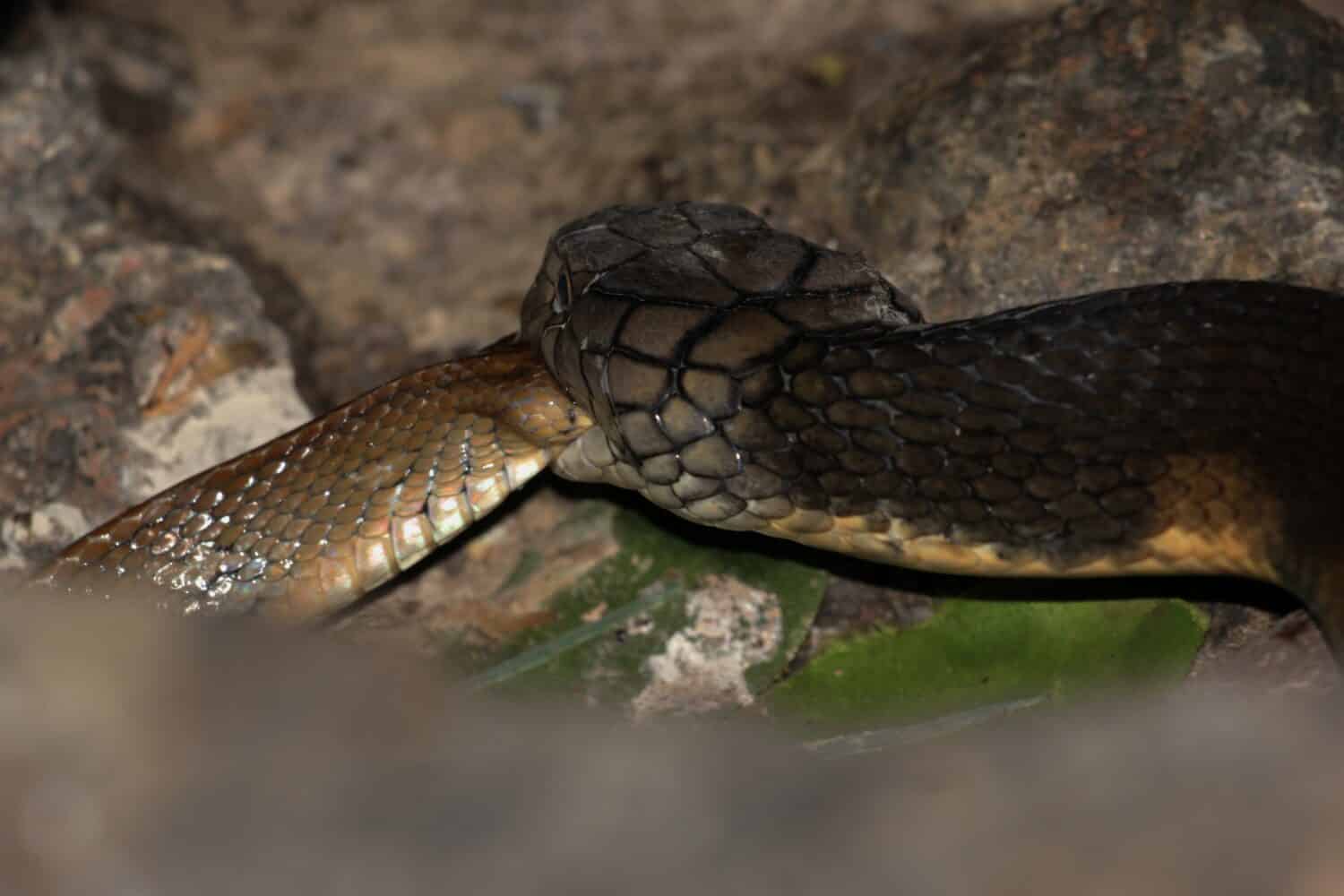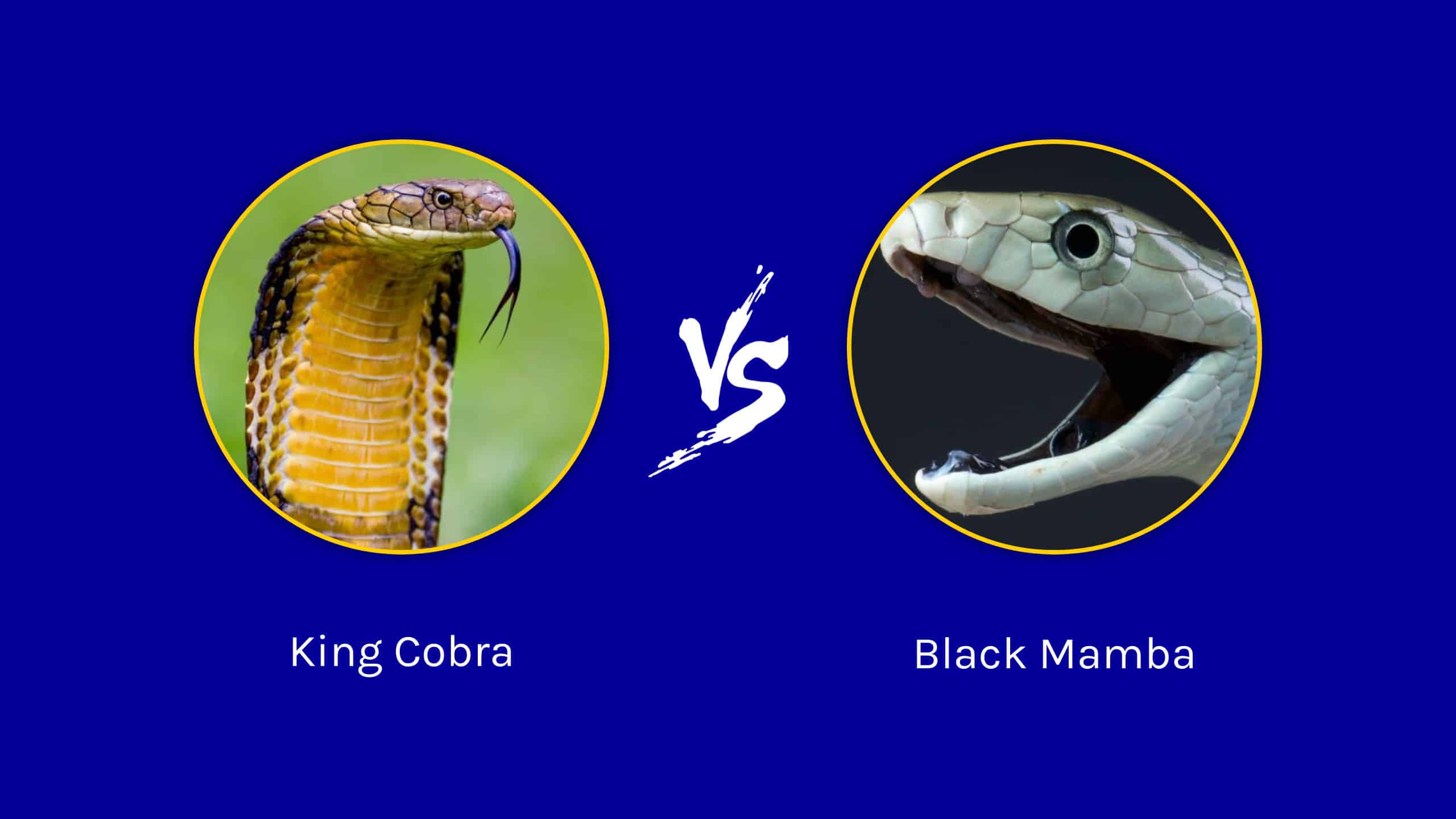Venomous snakes strike fear in people throughout the world. Just four species of snakes on the Indian subcontinent kill 50,000 people every year. Yet, snakes are more likely to target one another as a source of food than they are to try biting a person. What would happen if two of the world’s deadliest snakes battled? Today, we’re going to ask, king cobra vs. black mamba: which deadly snake would win in a fight?
Comparing a King Cobra and a Black Mamba
| King Cobra | Black Mamba | |
|---|---|---|
| Size | Weight: 10 to 15 pounds Length: 10 to 13 feet, up to 18 feet | Weight: 3.5 to 4.5 pounds Length: 6 to 9.5 feet, up to 14 feet. |
| Speed | Can reach 5 mph over short distances by slithering. | Can slither about 7 to 12 mph. |
| Defenses | – Size – Threat display to scare off other animals – Some resistance to other snake venoms – Ability to hide within its range | – Threat display – Not afraid to defend itself in a fight – Speed to escape situations |
| Offensive Capabilities | – Can rear back into a striking position that puts their head several feet off the ground – Powerful venom with an LD50 of about 1.28 mg/kg – Long fangs measuring half an inch – Deliver 400 to 500 mg of venom per bite | – May also pull itself into a striking position with several feet of its body off the ground – Immensely powerful venom with an LD50 between 0.25 and 0.32 mg/kg – Believed to envenomate with every bite |
| Predatory Behavior | Ambush predator that specializes in killing and eating other snakes | Ambush predators that sometimes kill other smaller snakes |
What Are 3 Key Differences Between a King Cobra and a Black Mamba?

Black mambas are speedy and deadly, capable of killing a person in 30 minutes.
From a fighting standpoint, the king cobra and black mamba have several differences including size, speed, and venom potency. The king cobra is larger than the black mamba, weighing 10 to 15 pounds while the black mamba weighs between 3.5 and 4.5 pounds.
The black mamba is much faster than the king cobra. While the average king cobra can move at speeds of 5 mph, the black mamba moves between 7 and 12 mph, possibly up to 20 mph. Also, the black mamba has far superior venom in terms of potency alone.
The king cobra venom has an LD50 of about 1.28 mg/kg. Meanwhile, the black mamba’s venom potency reaches an LD50 between 0.25 and 0.32 mg/kg. These unique qualities will have a significant impact on the fight between the two species.
What Are the Key Factors in a Fight Between a King Cobra and a Black Mamba?

King cobras use their size to overwhelm smaller snakes.
©Suresh Suryasree/Shutterstock.com
In this matchup between the king cobra vs. black mamba, the key factors are going to boil down to their size, ability to fight, speed, defenses, and predatory habits. By exploring each of these elements, we’ll figure out which snake is going to win the battle.
King Cobra vs. Black Mamba: Size
The king cobra is much larger than the black mamba in terms of weight and length. King cobras weigh between 10 and 15 pounds while the black mamba weighs 3.5 to 4.5 pounds. Also, the king cobra can grow between 10 and 13 feet, possibly up to 18 feet long. Meanwhile, the black mamba grows between 6 and 9.5 feet on average, and they reach maximum lengths of about 14 feet.
The king cobra has the size advantage.
King Cobra vs. Black Mamba: Speed
The black mamba is widely considered one of the fastest snakes. They can slither at speeds of 7 to 12 mph, but some sources insist they can move at 20 mph over short distances. Meanwhile, the king cobra only moves at speeds of 5 mph, and that measure is over short distances.
The black mamba has the speed advantage.
King Cobra vs. Black Mamba: Defenses
The king cobra and black mamba are somewhat similar in terms of their defenses. When confronted, both snakes will put on a threat display. Black mambas will gape their mouths and flick their tongue while hissing. Black mambas assume a typical S-shaped striking pose.
Meanwhile, king cobras draw their body off the ground to make themselves look bigger and to get ready to strike. They will flare their hoods and hiss as they do this. This defensive stance is also offensive in nature. It helps them tower over other animals, forcing them to get close to strike or flee. When other snakes flee, the king cobra will deliver a fatal attack.
King cobras rely on their size to fight other animals, including snakes. They also have a limited tolerance to some snakes’ venom. Black mambas use their superior speed to stay out of dangerous situations. Both snakes prefer to stay out of sight unless they’re trying to hunt.
The king cobra’s body size and striking pose give it an advantage in defense.
King Cobra vs. Black Mamba: Offensive Capabilities
The king cobra is the longest venomous snake in the world. They have great offensive capabilities in terms of the way they tend to tower over their favored prey: other snakes. They utilize their large size to take down other snakes and overpower them. King cobras have powerful venom with LD50 of 1.28 mg/kg and the capability to deliver about 420 mg per bite.
The black mamba is a very fast snake, and its venom is incredibly potent. They rarely, if ever, deliver dry bites. Their venom has an LD50 between 0.25 and 0.32 mg/kg. They often deliver upwards of 100 mg of venom during an attack. While they lack the size of the king cobra, their venom is much stronger.
The offensive powers of the king cobra are stronger than those exhibited by the black mamba, so it has the advantage.
King Cobra vs. Black Mamba: Predatory Behavior
Both king cobras and black mambas are ambush predators. However, the king cobra actively feasts on other snakes. The species’ scientific name is Ophiophagus hanna. The first name is Greek, and it means “snake eating.” While black mambas do feed on smaller snakes from time to time, they mostly eat small mammals and birds.
Who Would Win in a Fight Between a King Cobra and a Black Mamba?

King cobras specialize at killing and eating other snakes.
©Padodo/Shutterstock.com
A king cobra would beat a black mamba in a fight using its superior size and specialization as a snake eater to deliver a killing blow. Assuming both snakes were aware of each other and had nowhere to flee, the king cobra would live up to its name. The two snakes would size up one another. The black mamba would realize it has nowhere to go and become aggressive. The king cobra would encroach on the smaller snake’s space getting closer and closer before practically tackling the smaller snake, delivering a powerful bite to the mamba’s head.
Certainly, the black mamba is faster and has deadlier venom compared to the king cobra on a drop-per-drop basis. However, king cobras also have very potent venom, and they inject massive amounts of it into their prey at a time. They also have long fangs that help deliver their venom wherever they strike, often on the heads of smaller snakes.
While the black mamba is not a tiny snake by any means, it is shorter and lighter than the king cobra. To the latter, the small size of the black mamba makes it a potential meal.
King cobras have limited resistance to some snake venom, but it’s believed that resistance is only for snakes in their range. Even then, it’s not enough to stave off the venom of a black mamba or many other snakes, including its own kind. Yet, king cobras consistently kill smaller cobras, even when the prey lands a bite on them.
If king cobras tangle with other venomous snakes and win using their size, posture, speed, and venom, then it seems very likely that they would kill a black mamba as well. However, that doesn’t mean the king cobra survives the encounter in every case, too. The king cobra could kill the black mamba and later succumb to its venom.
Discover the "Monster" Snake 5X Bigger than an Anaconda
Every day A-Z Animals sends out some of the most incredible facts in the world from our free newsletter. Want to discover the 10 most beautiful snakes in the world, a "snake island" where you're never more than 3 feet from danger, or a "monster" snake 5X larger than an anaconda? Then sign up right now and you'll start receiving our daily newsletter absolutely free.
Thank you for reading! Have some feedback for us? Contact the AZ Animals editorial team.








